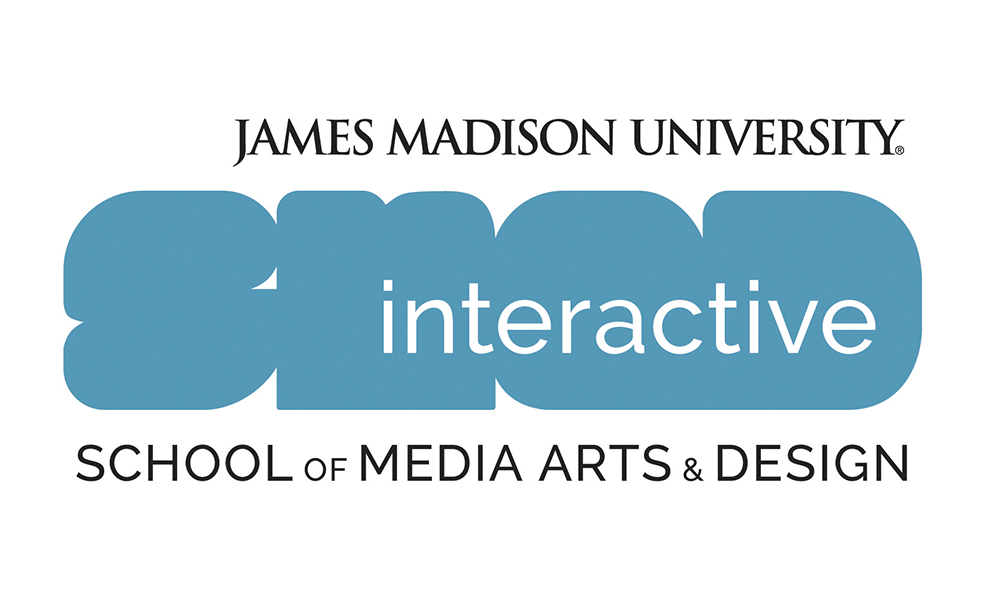Interactive Design students chose their own adventures in capstone classes
Media Arts and Design
By Charlotte Matherly, staff writer
When senior SMAD major Kelsey Robertson arrived in SMAD 408 this fall, she decided it would be the perfect opportunity to build the app she’d been wanting to design for more than a year — one that can support Harrisonburg businesses struggling through the COVID-19 pandemic.
“Basically, it focuses on restaurants,” Robertson said. “It offers an app discount, menus, wait times, and basically [is] one central app for all the different local restaurants who might not have an easy-to-use mobile platform.”
Because of the pandemic, Interactive Design capstone classes SMAD 404 and SMAD 408 have shifted from their normal combined effort to build products for potential clients, which usually culminates with a public event at the end of the semester. Instead, students in each class have branched out to work on individual projects and turn their ideas into reality.
“I’ve often referred to it as a choose-your-own-adventure type of semester, which in some ways is a little bit more work on the management side,” said David Wang, an assistant professor in SMAD, who teaches SMAD 408. “But because everybody’s … working on their own different things, it’s been kind of nice to have a little bit more variation when people come and share.”
As part of SMAD 408, called “Converged Media Lab,” Wang set up workshops over Zoom for students to interact with alumni as part of the class.
Wang said some students worked on personal portfolios or self-promotion projects because part of the capstone class is meant to ensure SMAD students are ready to enter the workforce. Others are reworking research, prototypes, and projects from past SMAD courses. Still others are working on improving accessibility to their websites and apps by incorporating features such as voice commands.
The converged media lab had an introduction week of sorts, Wang said, but when JMU shifted completely online in September, the class re-focused on the course’s textbook and discussions in response to the readings. All of that prepared students to complete the final product, he said. Then, from October through the end of the semester, they focused mostly on their independent projects.
Robertson said the biggest challenge brought by COVID-19 has been conducting user research in a virtual format. She said she usually uses a paper prototype to see if potential users can understand the app’s format and if they can complete simple tasks. Because she couldn’t physically be with the user, though, she created a low-tech digital prototype for participants to use and discussed the product with them over Zoom.
“[I’m] just trying to keep everything as normal as possible … but also keeping everything virtual, keeping everyone distanced,” Robertson said. “That’s definitely been the most challenging for me.”
SMAD 404, “Advanced Interactive Design,” is taught by Shelly Hokanson, an associate professor in SMAD. Hokanson said her class only has three students this semester, so instead of collaborating with SMAD 408, each student created an informational or advocacy project. One student created a project about systemic racism, one focused on media literacy, and third explored the history of denim jeans.
Hokanson said the class covers the entire process of building and selling a product. Students start by conducting user research analysis and forming design requirements off those results. Then, they build an interactive prototype. Students also turn in a video or written walkthrough of their product suitable to present to potential investors.
“You have everything from start to finish, from just envisioning the project through constructing the project through testing the project on users,” Hokanson said. “Once it’s been created, through how you would pitch it if you were selling your idea to somebody.”
While SMAD 404 doesn’t have an online showcase yet, Hokanson said Dr. Chen Guo, an assistant professor in SMAD, is creating a website to house all projects from the Interactive Design concentration.
Hokanson said she misses the collaboration of the two capstone classes and having students work to build products for real clients.
“Hopefully, next fall, we can get back to everything normal the way it was intended to be,” Hokanson said. “We’re making it work in this temporary situation, but it’ll be nice to get back to … the competition and the prizes and all that good stuff.”
